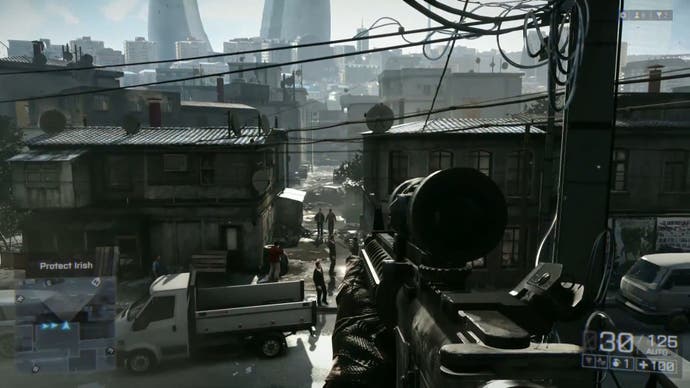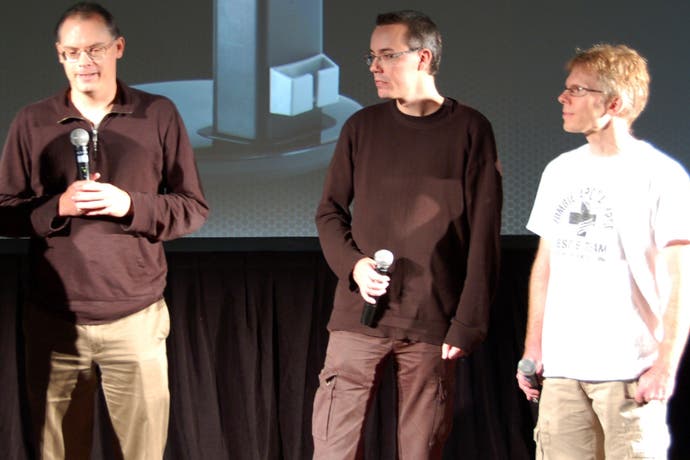Carmack, Sweeney and Andersson Unplugged
The big three rendering architects effectively did an AMA at the G-Sync launch. Here's the transcript.
Nvidia recently announced G-Sync - a new display technology that eliminates screen-tear from PC gaming forever, while eliminating the judder experienced when traditional v-sync gaming drops frames. Endorsing the technology at the Montreal event were three of the most potent forces in video games rendering technology, past and present: Oculus VR's John Carmack, Epic's Tim Sweeney and DICE's Johan Andersson.
What began as an informal Q+A about current projects and the G-Sync technology - hosted by Tony Tamasi, Nvidia's Senior Vice President of Content and Technology - swiftly expanded out into many different directions as the assembled press, Digital Foundry included, were invited to pitch questions on any topic we wanted. The result is a hugely intriguing outlook on how three of the most gifted rendering architects in the history of gaming see current hot topics such as AMD's Mantle, Valve's Steam Machines, virtual reality and 4K displays.
It's an event we really wanted to bring to you - but the question we grappled with was just how to do it? Our chosen solution was to transcribe the lot, edit where we could and then group questions and discussion points together so all the relevant information sits together, rather than dotted throughout the talk as it was on the day. Combine that with some attempt at making the topics navigable and what you have is the article we've put together here.
Just think about this for a second: Carmack, Sweeney and Andersson in one room, taking part in the physical equivalent of a Reddit AMA. It's a once in a decade opportunity and we've tried our best to get all the important information - plus the sheer sense of occasion - across in this article.
Many thanks to John Linneman for tackling the awesome challenge of the transcription.
Sure, for the last year or so I haven't had much time to program as I've mostly been seeing over Epic's transition into the next generation. What Epic is working on is really exciting. We've been building Unreal Engine 4 for about three years now and it's in really incredible shape, running on everything from an iPhone to a next-generation console to the highest end PC available. It's just an incredibly big and powerful engine.
Back when the original Unreal Engine was written it was just me for about two years and then I was joined by two other programmers to complete it and now UE4 is a product of over one hundred people working for many, many years. We're approaching maybe four or five hundred man-years of it. Of course that's powering a bunch of games throughout the industry including Epic's next upcoming project, which is known as Fortnite.
It's a PC-focused game, an online game which we'll be operating as a service and you'll be able to download it and go play it without ever going into a retail store. It's a super cool game which combines building environments by day and then defending them against zombies by night, much like Minecraft meets Left 4 Dead with a kind of Pixar-style art direction - which has been a real nice contrast to building super ultra realistic projects with Gears of War. So we're talking about all this and we're also working on other things, and I'll just leave it at that.
"Back when the original Unreal Engine was written it was just me for about two years and then I was joined by two other programmers... and now UE4 is a product of over one hundred people... we're approaching maybe four or five hundred man-years of it." - Tim Sweeney, Epic Games.

We've been working on quite a few things, I would say, in Frostbite we've been sort of slowly, organically growing... mostly because our games have been becoming more complex and also because we're a part of Electronic Arts and we have a lot of games within EA. So one of the things we really are quite excited about is seeing these completely different types of games that we've never done on our engine. Seeing Command and Conquer, which we didn't really think was possible to do with our engine, but they've managed to do that and it's really awesome.
Same with BioWare working on Dragon Age and Mass Effect which is awesome, one of my favourite game series. Being able to work on the things you love with technology and graphics specifically and high performance stuff but doing that in a context of having the creativity of all of those different game teams that are very, very different and [have] very different cultures also that are under the same roof, so we can collaborate in a very intimate fashion and see sort of what works and what works for various types of teams and what technology we can harvest and combine - so that's really cool.
As part of this, back at DICE now we're a big, big studio... we get to work with more people and we get to see this interesting mix of technology. OK, these guys are working on this system here but then they're working on this soccer game here and these guys have been doing some awesome work on some other components, then they're able to harvest and see. That's a different way than we've ever worked before and that's really exciting and then, on the other hand, another aspect overall we've been focusing on a lot is just really low-level performance and working on the next generation consoles but also on the PC and just seeing where can we get to with graphics on that level and then what can we build on top of such a foundation.
"Another aspect overall we've been focusing on a lot is just really low-level performance and working on the next generation consoles but also on the PC and just seeing where can we get to with graphics on that level." - Johan Andersson, DICE.

Yeah, so, after we shipped Rage I treated myself by saying I'm going to go do a little research and I'm going to go look into the state of virtual reality. If we go back in time 20-something odd years there was the original promise of virtual reality in the early 90s. I was involved in that to some degree - we licensed Wolfenstein, Doom and Quake for these VR companies but they were all very hands-off because I thought they were all loser bets.
At the time it was one of those things where there were serious people doing serious things at NASA and some research universities but they looked down their nose at entertainment applications, and it was all surgery and architectural walkthroughs, but all the promoters were very much hucksters and, you know, it's like, "OK, we'll take your money to do the game but it's not going to amount to anything," and I thought, twenty years have passed, you know, but everybody had the vision of what we wanted from virtual reality and we all remember that. We wanted to be transported to another world, games are an approximation of this and surely somebody has done it now in the last 20 years.
I was really kind of shocked that really nobody had that, while we've had six orders of magnitude of improvement in our performance, that's just an almost incomprehensible number, but this stuff that felt maybe a little out of reach 20 years ago nobody had yet grabbed it, and when I came in and really started looking around, what is there, what's necessary to do, obviously you have the graphics in hand but what's changed on the displays and the position tracking and the various other aspects of it, it seemed more and more like we kind of just do this right now, this is in reach.
I was doing a bunch of things that I was kind of building, we were trying to figure out some way, how do you promote, like, Doom 3 BFG, which was an old game being re-released, and I'm thinking well, I'm doing this stereoscopic 3D stuff and people have 3DTVs and I'm not a huge fan of but this head mounted display stuff I have in my room back here is having a pretty big impact on me and we decided we're going to use this as one of our sort of promotional hooks.
"I've been in this position where the last couple months I've been heads down, locked in a room working really hard on a lot of core technology issues and in many ways I feel more like myself than I have in a long time." - John Carmack, Oculus VR.

Before E3 I had been in touch with this guy - Palmer Luckey - who had basically built an HMD [head-mounted display]. I had been using a couple of other cobbled together ones, some that I had built, some that I had gotten from various places, but this thing that he had taped together was sort of a better experience with a wider FOV than anything that I had, any of the commercial ones. I used that, I showed Doom 3 BFG in virtual reality at E3 and it had a huge impact. We had so many people saying that, all the talk of the Wii U or the leaks of next-gen console stuff that it was actually more exciting to see this duct-taped together, hot-glued little prototype... they went off and Oculus was founded.
They had a super successful Kickstarter, I went back to kind of doing the work that I was doing and things didn't really come together very well between the companies, and a couple months ago I decided that I was going to move to working full time at Oculus... It's interesting where I had been through these six orders of magnitudes of performance and I can look at some of this stuff and say I remember what it felt like when we took our 2D games and put them into first person perspective and how there is this feeling that this means something, that we're doing something different.
It may be the same that you're picking things up and shooting but it is different and FPSs have been a persistent, dominant genre over that time period since then, and I get that same sense with [the] virtual reality side of things. Right now there's thirty odd thousand with dev kits that have gone out... and there are all these things that are sub-optimal and need to be improved but a lot of people can see the magic. They can see that we're not there yet, it's our job to get us there, but we can see where we're going and it is magic and it is something that will make a bigger difference than the next couple of orders of magnitude that we throw at it with GPU power.
So, I've been in this position where the last couple months I've been heads down, locked in a room working really hard on a lot of core technology issues and in many ways I feel more like myself than I have in a long time. There are a lot of things that I'm having an absolute blast doing, working extremely hard pushing towards hard near-term deadlines trying to make things that matter that create a lot of value for people in a new way so I am, as anybody who has been talking to me about it [will know], I am super energised and excited about what we're doing. It's going to make a bit of a dent.









